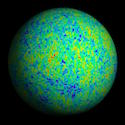|
|
On this page... (hide) 1. Analytical problem :equation to solve for {$ \mathbf E_\ell $} {$\mathbf C^{AA} \mathbf E_\ell \mathbf C^{BB} + \mathbf C^{AB} \mathbf E_\ell^T \mathbf C^{AB} = \mathbf P_{\ell} $} of when expended : {$ 2 \mathbf S \mathbf E_\ell \mathbf S + \mathbf N^{AA} \mathbf E_\ell \mathbf S + \mathbf S \mathbf E_\ell \mathbf N^{BB} + \mathbf N^{AA} \mathbf E_\ell \mathbf N^{BB} = \mathbf P_{\ell} $} 1.1 Approximation :At this stage, we must approximate the shape of the pixel covariance matrices. We consider two extreme cases :
Both limits give a solution of the form {$ \mathbf E_\ell \simeq \frac 1a \sum_{\ell' } B_{\ell\ell'} (\mathbf C^{AA})^{-1} \mathbf P_{\ell'} (\mathbf C^{BB})^{-1} $} We will come back to this assumption in the simulations analysis. Where {$1 \leq a \leq 2$} is a normalization coefficient that depends on the signal-to-noise level as discussed above. We absorb this factor such that {$B_{\ell\ell'} = a \tilde B_{\ell\ell'}$}. Finally, imposing {$ Tr [\mathbf E_\ell \mathbf P_{\ell'} ] = \delta_{\ell\ell'}$} gives {$ Tr[ \sum_{\ell'' } \tilde B_{\ell\ell''} (\mathbf C^{AA})^{-1} \mathbf P_{\ell''} (\mathbf C^{BB})^{-1} \mathbf P_{\ell'} ] = \delta_{\ell\ell'} $} {$ \Leftrightarrow ~ 2 \mathcal B \cdot \mathcal F = \mathbb 1 $} {$ \Rightarrow ~ \tilde {\mathcal B} = \frac1{2} \mathcal F^{-1} $} where we define {$ F_{\ell \ell'}^{AB} \equiv \frac 12 Tr[(\mathbf C^{AA})^{-1} \mathbf P_{\ell} (\mathbf C^{BB})^{-1} \mathbf P_{\ell'}] $} as the 'cross' Fisher information matrix (see {\color{blue} cite}). We get the fully written spectrum estimator {$ \hat C_\ell^{AB} = \sum_{\ell'} [ F^{-1}] _{\ell \ell'} \mathbf d^A ( \mathbf C^{AA})^{-1} \mathbf P_{\ell'} ( \mathbf C^{BB})^{-1} \mathbf d^B. $} 1.2 Exacte solution of the Sylvester equation :
A matrix equation of the form {$ A E B = P$}, where {$E$} is the unknown, can be linearly transformed into the form {$ (A \otimes B) e = p$}. And {$e$} is the vectorization of the matrix {$E$} , same for {$p$}. The expended equation above thus becomes {$ ( 2 \mathbf S \otimes \mathbf S + \mathbf N^{AA} \otimes \mathbf S + \mathbf S\otimes \mathbf N^{BB} + \mathbf N^{AA} \otimes \mathbf N^{BB} ) e_\ell = p_{\ell} $} and can be solved exactly. Also known as the Sylvester equation. Using a linear solver algorithm (rather than inversing the matrix).
2. Results :In the xQML code, the there is no normalization factor {$ B_{\ell\ell''} $} or {$a$} in {$E_\ell$}, since those cancel out in the end, for the final spectrum estimator and analytical variance estimate. We thus simply compute {$E_\ell = (\mathbf C^{AA})^{-1} \mathbf P_{\ell} (\mathbf C^{BB})^{-1} $} and {$F_{\ell\ell'} = Tr[ E_\ell P_{\ell'} ] $} Approximation Vs ExacteEl matrix
Spectrum estimator and variance impact :2.1 LiB :We plot the estimator spectrum errors ratio (minus one) between the approximation and the exact solution for {$ E_\ell $}, using a wide range of noise level (between 0.1 muK to 2000.0 muK). The ratio is computed from the diagonal of the covariance matrix (EE ++ BB )
2.2 Bicep :Same analysis for bicep :
|
|

























